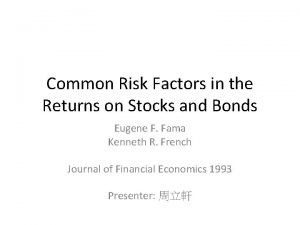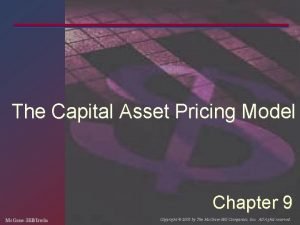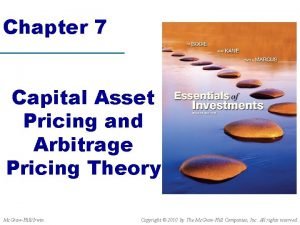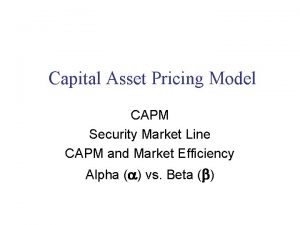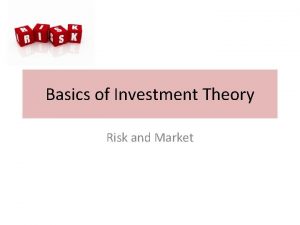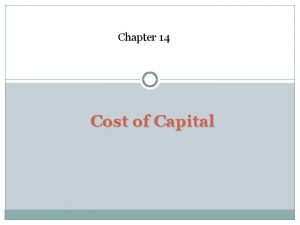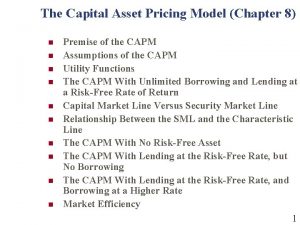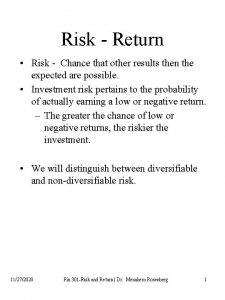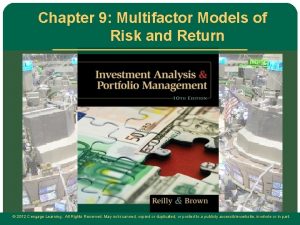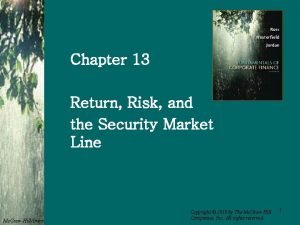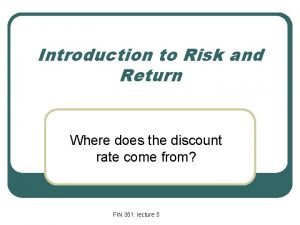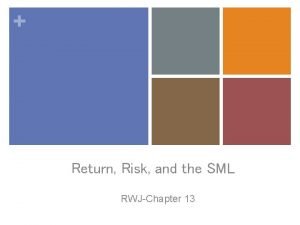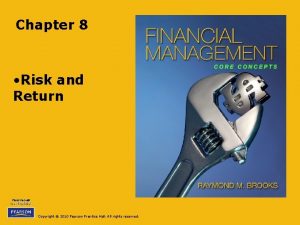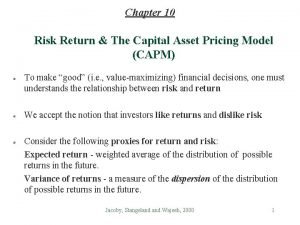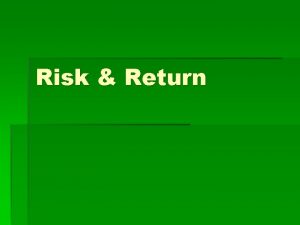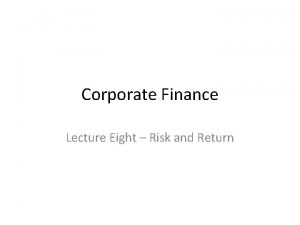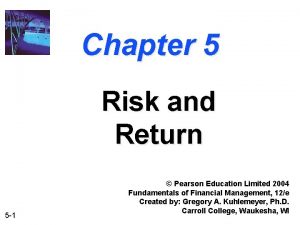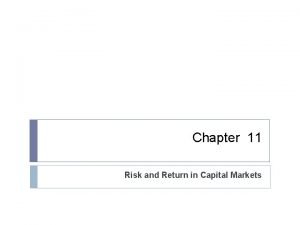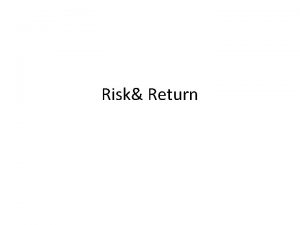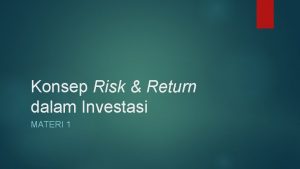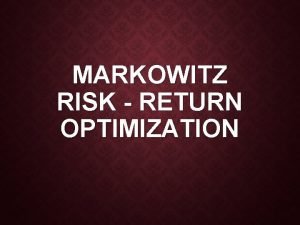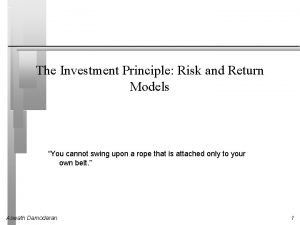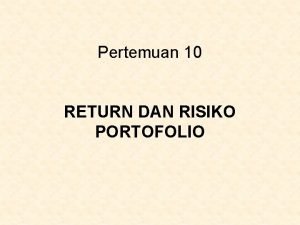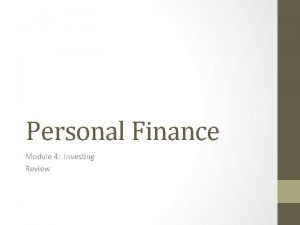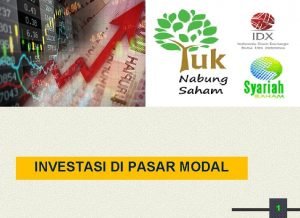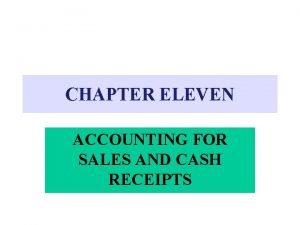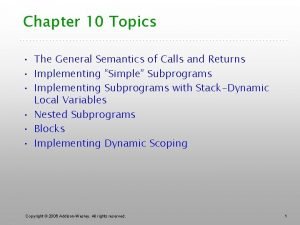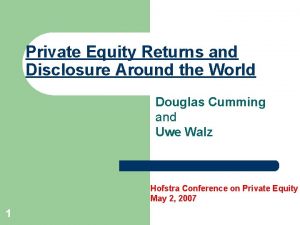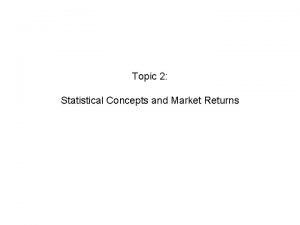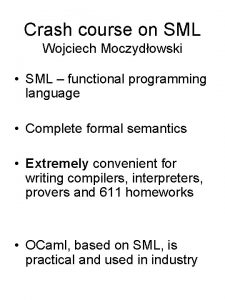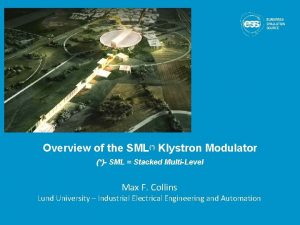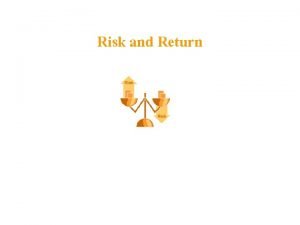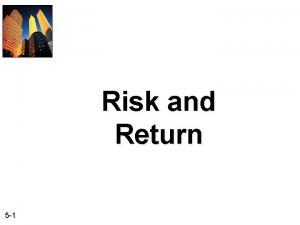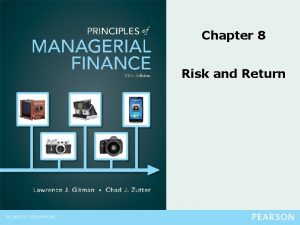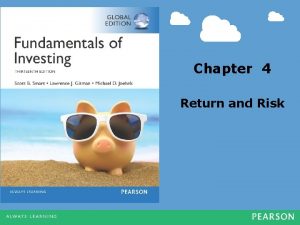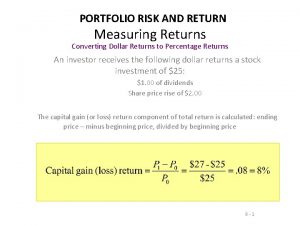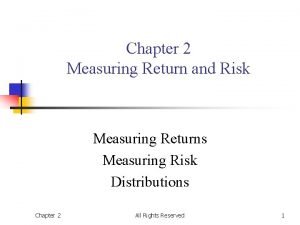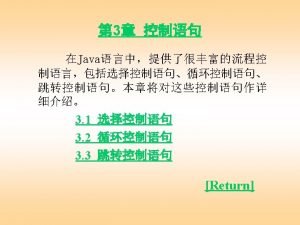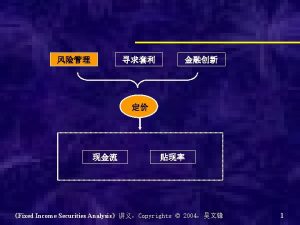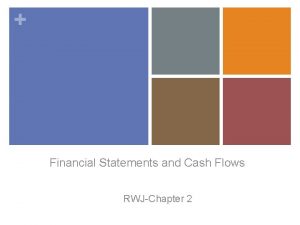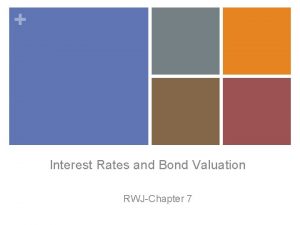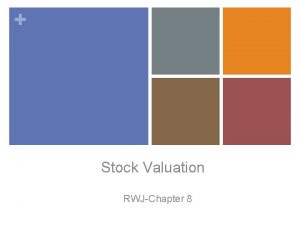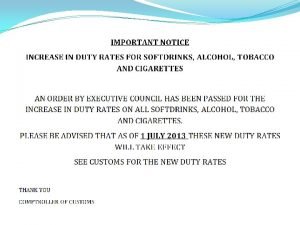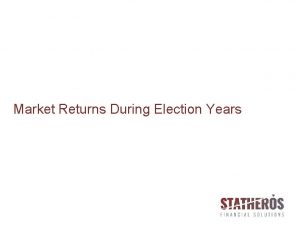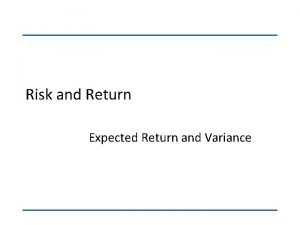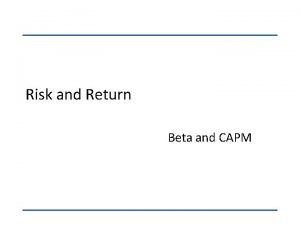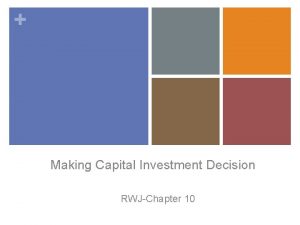Return Risk and the SML RWJChapter 13 Returns






































- Slides: 38

+ Return, Risk, and the SML RWJ-Chapter 13

+ Returns n Dollar Returns n the sum of the cash received and the change in value of the asset, in dollars. Dividends Ending market value Time 0 1 • Percentage Returns Initial investment – the sum of the cash received and the change in value of the asset divided by the original investment.

+ Holding Period Return (Simple Return) OR Capital Gain Dividend Yield

+ HPR (Simple Return)-Example n Suppose you bought 100 shares of Wal-Mart (WMT) one year ago today at $25. Over the last year, you received $20 in dividends (= 20 cents per share × 100 shares). At the end of the year, the stock sells for $30. How did you do? n What is your return on this investment?

+ Dollar Return: $520 gain $20 $3, 000 Time 0 1 Percentage Return: -$2, 500 20. 8% = $520 $2, 500

+ HPR (Simple Period)- Example n Let’s look at Ford Source=Yahoo Finance Capital Gain=2. 16%% Dividend Yield=0. 54%

+ HPR- Multiple Periods n The holding period return is the return that an investor would get when holding an investment over a period of n years, when the return during year i is given as ri: n Compounding Return: The cumulative effect that a series of gains or losses on an original amount of capital over a period of time

+ HPR (Multiple Periods)- Example (3) n Suppose your investment provides the following returns over a four-year period:

+ Annualizing Return n How can I annualize my return over time? n Two ways: n Arithmetic Average n Geometric Average

+ Example n Average (Arithmetic Return)? n Geometric Return? n Interpret the results

+ Risk: n What is risk? n Webster’s dictionary: “exposing to loss or damage” n In finance: n Stand-alone basis n Portfolio basis

+ Which one is more risky? Why?

+ Risk and Return Relation: Is risk a bad?

+ Historical Returns, 1926 -2014 Series Average Annual Return Standard Deviation Large Company Stocks 12. 1% 20. 1% Small Company Stocks 16. 7 32. 1 Long-Term Corporate Bonds 6. 4 8. 4 Long-Term Government Bonds 6. 1 10. 0 U. S. Treasury Bills 3. 5 3. 1 Inflation 3. 0 4. 1 – 90% Distribution 0% + 90%

+ How to measure Risk? n Likelihood that investors will receive a return on an investment that is different from the return they expected to make n Two important key words in this definition n Expectations n Deviation from our expectations

+ To measure Risk: We need to know two concepts? n TIME SERIES ARE GIVEN n Expected Return: n Expected Return How much “actual return” deviates from “Expected Return”? Variance

+ To measure Risk: We need to know two concepts? n PROBABILITY DISTRIBUTION GIVEN n Probability: n n The chance that event will occur Probability Distribution: n If all possible events, or outcomes, are listed, and if probability is assigned to each event, the listing is called probability distribution.

+ Then: n Expected Return: Expected Return n How much “actual return” deviates from “Expected Return”? Variance

+ Example n What is the expected return of Stock X?

+ d 4 d 1 d 3 d 2 Standard Deviation

+ The Risk-Return Tradeoff

+ Risk Statistics n There is no universally agreed-upon definition of risk. n The measures of risk that we discuss are variance and standard deviation. n The standard deviation is the standard statistical measure of the spread of a sample, and it will be the measure we use most of this time. n Its interpretation is facilitated by a discussion of the normal distribution.

+ n Normal Distribution A large enough sample drawn from a normal distribution looks like a bell-shaped curve. Probability The probability that a yearly return will fall within 20. 1 percent of the mean of 12. 1 percent will be approximately 2/3. – 3 s – 48. 2% – 2 s – 28. 1% – 1 s – 8. 0% 0 12. 1% 68. 26% 95. 44% 99. 74% + 1 s 32. 2% + 2 s 52. 3% + 3 s 72. 4% Return on large company common stocks

+ Interpretation of Risk n The 20. 1% standard deviation we found for large stock returns from 1926 through 2014 can now be interpreted in the following way: n If stock returns are approximately normally distributed, the probability that a yearly return will fall within 20. 1 percent of the mean of 12. 1% will be approximately 2/3.

+ Diversification and Systematic Risk n What is diversification? n Spreading a portfolio over many investments to avoid excessive exposure to any source of risk

+ Diversifiable vs. Market Risk n n To the extent that the firm specific influences on two stocks differ, diversification should reduce portfolio risk n With all risk sources independent, the exposure to any particular source of risk is reduced to a negligible level n Firm specific risk is called unsystematic, unique risk, idiosyncratic risk, or diversifiable risk The risk remains even after extensive diversification. This risk is called market or systematic risk

+ Factors Affecting Unsystematic and Systematic Risk n n Unsystematic (Unique) Risk: n Successful or unsuccessful product or marketing program n Winning or loosing of a major contract n In particular: good or bad news for a firm Systematic Risk: n Economic conditions; recession, boom, high inflation, high interest rates

+ Diversification Unique Risk Systematic Risk

+ Market Risk

+ Summary: n Based on the studies on capital market history, we know that there is reward, on average, for bearing risk. n Since, unsystematic risk can be eliminated at virtually no cost (by diversifying), there is no reward for bearing it. Put another way, the market does not reward risks that are borne unnecessarily. n Implication: n The expected return on an asset depends only on that asset’s systematic risk n No matter how much total risk an asset has, only the systematic portion is relevant in determining the expected return

+ How to Measure Systematic Risk? Estimation of Beta n Beta is a measure of stock’s volatility in relation to the market or the responsiveness of a security to movements in the market portfolio (i. e. , systematic risk). n Estimation made using t=1, 2, 3, … , T

+ Example-Expected Return of a Portfolio n You have $10, 000, what is your portfolio return if you invest $2000 in Stock X (Beta X=2) and $8000 in Stock Y (Beta Y=0. 5). Let’s assume expected return for Stock X and Stock Y is 20% and 10% respectively. What is the expected return of Portfolio? What is the expected Beta of Portfolio?

+ Portfolio Beta and Security Market Line n Weighted average Betas of the stocks in the portfolio n SML: Expected Return and Systematic Risk Relation:

+ How to measure systematic risk? n Because systematic risk is the crucial determinant of an asset’s expected return, we need some way of measuring the level of systematic risk for different investment. n β (Beta Coefficient) tells us how much systematic risk as an average asset n Market Beta=1 n Risk Free Rate Beta=0 n Stock A: Standard Deviation=40%, Beta=0. 50 n Stock B: Standard Deviation=20%, Beta=1. 50 n Ford: http: //www. google. com/finance? q=ford&ei=p. ISCUt. Cm. Io. G 20 AH 2 PA

+ Example (7) n Let’s assume that you have a market portfolio (S&P 500) and risk-free rate asset (T-bills). Expected rate of Market Portfolio is 10% and risk-free rate is 3% What is the expected return and Beta if you invest: n 100% in risk free rate n 75% in risk free rate and 25% in Market Portfolio n 50% in risk free rate and 50% in Market Portfolio n 25% in risk free rate and 75% in Market Portfolio n 100% in Market Portfolio

+ Market Risk Premium

+ The SML and the Cost of Capital: A Preview n Risk is an extremely important consideration in almost all business decisions. Therefore, we need to the find the relation between risk and return (the SML) n We also need to know what determines the appropriate discount rate for future cash flows: Market risk premium, risk free rate and Beta n Why is the SML important: n It tells us reward to risk in financial markets n In order to find the discount rate: we need to compare the expected return on that investment to what the financial market offers on an investment with the same beta. In other words, the SML line tells us the “going rate” for bearing risk in the economy.

+ The SML and the Cost of Capital: A Preview n Cost of Capital: the appropriate discount rate on a new project is the minimum expected rate of return an investment must offer to be attractive n This minimum required rate of return is called “Cost of Capital” n We have a much better idea of what determines the required return on investment.
 Common risk factors in the returns on stocks and bonds*
Common risk factors in the returns on stocks and bonds* Market risk assessment
Market risk assessment Cov(ri rm)
Cov(ri rm) Slope of sml
Slope of sml Security market line alpha
Security market line alpha Slope of sml
Slope of sml Chapter 14 cost of capital
Chapter 14 cost of capital Assumption of capm
Assumption of capm Sml online compiler
Sml online compiler The following are advantages of the sml approach
The following are advantages of the sml approach Risk and return
Risk and return Risk and return
Risk and return Risk and return
Risk and return Multifactor models of risk and return
Multifactor models of risk and return Financial management chapter 8 risk and return
Financial management chapter 8 risk and return Chapter 13 return risk and the security market line
Chapter 13 return risk and the security market line Introduction to risk and return
Introduction to risk and return Risk and return
Risk and return Chapter 8 risk and rates of return problem solutions
Chapter 8 risk and rates of return problem solutions Risk return and capital asset pricing model
Risk return and capital asset pricing model Konsep risk and return
Konsep risk and return Difference between risk and return
Difference between risk and return Chapter 5 risk and return
Chapter 5 risk and return Difference between risk and return
Difference between risk and return Assume risk and return are positively related
Assume risk and return are positively related Konsep risk and return
Konsep risk and return Markowitz model of risk return optimization
Markowitz model of risk return optimization Risk return principle
Risk return principle Contoh diversifikasi markowitz
Contoh diversifikasi markowitz Module 4 investing
Module 4 investing Pengertian investasi
Pengertian investasi Four column ledger example
Four column ledger example General semantics of calls and returns
General semantics of calls and returns Private equity returns and disclosure around the world
Private equity returns and disclosure around the world Statistical concepts and market returns
Statistical concepts and market returns Residual risk and secondary risk pmp
Residual risk and secondary risk pmp Business risk and financial risk leverage
Business risk and financial risk leverage Relative risk and attributable risk
Relative risk and attributable risk Relative risk
Relative risk
